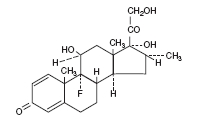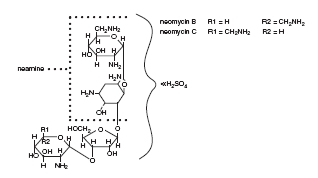METHEDEX- neomycin and polymyxin b sulfates and dexamethasone solution/ drops
Major Pharmaceuticals
----------
Neomycin and Polymyxin B Sulfates
and Dexamethasone
DESCRIPTION
Neomycin and Polymyxin B Sulfates and Dexamethasone Ophthalmic Suspension USP is a multiple dose anti-infective steroid combination in a sterile suspension for topical application. The active ingredient, Dexamethasone, is represented by the following structural formula:
C22H29FO5
Mol. Wt. 392.47
Chemical Name: Pregna-1,4-diene-3,20-dione, 9-fluoro-11,17,21-trihydroxy-16-methyl-, (11β,16α)-.
Neomycin Sulfate is the sulfate salt of neomycin B and C which are produced by the growth of Streptomyces fradiae Waksman (Fam. Streptomycetaceae). It has a potency equivalent to not less than 600 micrograms of neomycin base per milligram, calculated on an anhydrous basis. The structural formula is:
Polymyxin B Sulfate is the sulfate salt of polymyxin B1 and B2 which are produced by the growth of Bacillus polymyxa (Prazmowski) Migula (Fam. Bacillaceae). It has a potency of not less than 6,000 polymyxin B units per milligram, calculated on an anhydrous basis. The structural formula is:
Each mL Contains: ACTIVES: Neomycin Sulfate (equivalent to 3.5 mg Neomycin), Polymyxin B Sulfate equal to 10,000 polymyxin B units, Dexamethasone 1 mg (0.1%); INACTIVES: Sodium Chloride, Hypromellose, Polysorbate 20, Purified Water. Hydrochloric Acid and/or Sodium Hydroxide may be added to adjust pH (3.5 – 6.0).
PRESERVATIVE ADDED: Benzalkonium Chloride 0.004%
CLINICAL PHARMACOLOGY
Corticoids suppress the inflammatory response to a variety of agents and they probably delay or slow the healing. Since corticoids may inhibit the body’s defense mechanism against infection, a concomitant antimicrobial drug may be used when this inhibition is considered to be clinically significant in a particular case.
When a decision to administer both a corticoid and an antimicrobial is made, the administration of such drugs in combination has the advantage of greater patient compliance and convenience, with the added assurance that the appropriate dosage of both drugs is administered, plus assured compatibility of ingredients when both types of drugs are in the same formulation and, particularly, that the correct volume of drug is delivered and retained.
The relative potency of corticosteroids depends on the molecular structure, concentration, and release from the vehicle.
INDICATIONS AND USAGE
For steroid-responsive inflammatory ocular conditions for which a corticosteroid is indicated and where bacterial infection or a risk of bacterial ocular infection exists.
Ocular steroids are indicated in inflammatory conditions of the palpebral and bulbar conjunctiva, cornea, and anterior segment of the globe where the inherent risk of steroid use in certain infective conjunctivitis is accepted to obtain a diminution in edema and inflammation. They are also indicated in chronic anterior uveitis and corneal injury from chemical, radiation or thermal burns, or penetration of foreign bodies.
The use of a combination drug with an anti-infective component is indicated where the risk of infection is high or where there is an expectation that potentially dangerous numbers of bacteria will be present in the eye.
The particular anti-infective drug in this product is active against the following common bacterial eye pathogens: Staphylococcus aureus,Escherichia coli, Haemophilus influenzae, Klebsiella/Enterobacter species, Neisseria species, Pseudomonas aeruginosa.
This product does not provide adequate coverage against Serratia marcescens, and Streptococci, including Streptococcus pneumoniae.
CONTRAINDICATIONS
Epithelial herpes simplex keratitis (dendritic keratitis), vaccinia, varicella and many other viral diseases of the cornea and conjunctiva.
Mycobacterial infection of the eye. Fungal diseases of ocular structures. Hypersensitivity to a component of the medication. (Hypersensitivity to the antibiotic component occurs at a higher rate than for other components.)
The use of these combinations is always contraindicated after uncomplicated removal of a corneal foreign body.
WARNINGS
NOT FOR INJECTION
Prolonged use may result in glaucoma, with damage to the optic nerve, defects in visual acuity and fields of vision, and posterior subcapsular cataract formation. Prolonged use may suppress the host response and thus increase the hazard of secondary ocular infections. In those diseases causing thinning of the cornea or sclera, perforations have been known to occur with the use of topical steroids. In acute purulent conditions of the eye, steroids may mask infection or enhance existing infection. If these products are used for 10 days or longer, intraocular pressure should be routinely monitored even though it may be difficult in children and uncooperative patients.
Products containing neomycin sulfate may cause cutaneous sensitization.
Employment of steroid medication in the treatment of herpes simplex requires great caution.
PRECAUTIONS
General
The initial prescription and renewal of the medication order beyond 20 mL should be made by a physician only after examination of the patient with the aid of magnification, such as a slit lamp biomicroscopy and, where appropriate, fluorescein staining.
The possibility of persistent fungal infections of the cornea should be considered after prolonged steroid dosing.
ADVERSE REACTIONS
Adverse reactions have occurred with steroid/anti-infective combination drugs which can be attributed to the steroid component, the antiinfective component, or the combination. Exact incidence figures are not available since no denominator of treated patients is available.
Reactions occurring most often from the presence of the anti-infective ingredients are allergic sensitizations. The reactions due to the steroid component are: elevation of intraocular pressure (IOP) with possible development of glaucoma, and infrequent optic nerve damage; posterior subcapsular cataract formation; and delayed wound healing.
Secondary Infection: The development of secondary infection has occurred after use of combinations containing steroids and antimicrobials. Fungal infections of the cornea are particularly prone to develop coincidentally with long-term applications of steroids. The possibility of fungal invasion must be considered in any persistent corneal ulceration where steroid treatment has been used. Secondary bacterial ocular infection following suppression of host responses also occurs.
DOSAGE AND ADMINISTRATION
One or two drops topically in the conjunctival sac(s). In severe disease, drops may be used hourly, being tapered to discontinuation as the inflammation subsides. In mild disease, drops may be used up to four to six times daily.
Not more than 20 mL should be prescribed initially and the prescription should not be refilled without further evaluation as outlined in PRECAUTIONS above.
SHAKE WELL BEFORE USING.
HOW SUPPLIED
Neomycin and Polymyxin B Sulfates and Dexamethasone Ophthalmic Suspension USP is supplied in a controlled drop tip bottle in the following size:
5 mL - Prod. No. 04107
DO NOT USE IF IMPRINTED NECKBAND IS NOT INTACT.
FOR OPHTHALMIC USE ONLY
| METHEDEX
neomycin and polymyxin b sulfates and dexamethasone solution/ drops |
||||||||||||||||||||
|
||||||||||||||||||||
|
||||||||||||||||||||
|
||||||||||||||||||||
|
||||||||||||||||||||
| Labeler - Major Pharmaceuticals (191427277) |
| Registrant - Major Pharmaceuticals (191427277) |
| Establishment | |||
| Name | Address | ID/FEI | Business Operations |
|---|---|---|---|
| Major Pharmaceuticals | 191427277 | REPACK(0904-3003) | |



